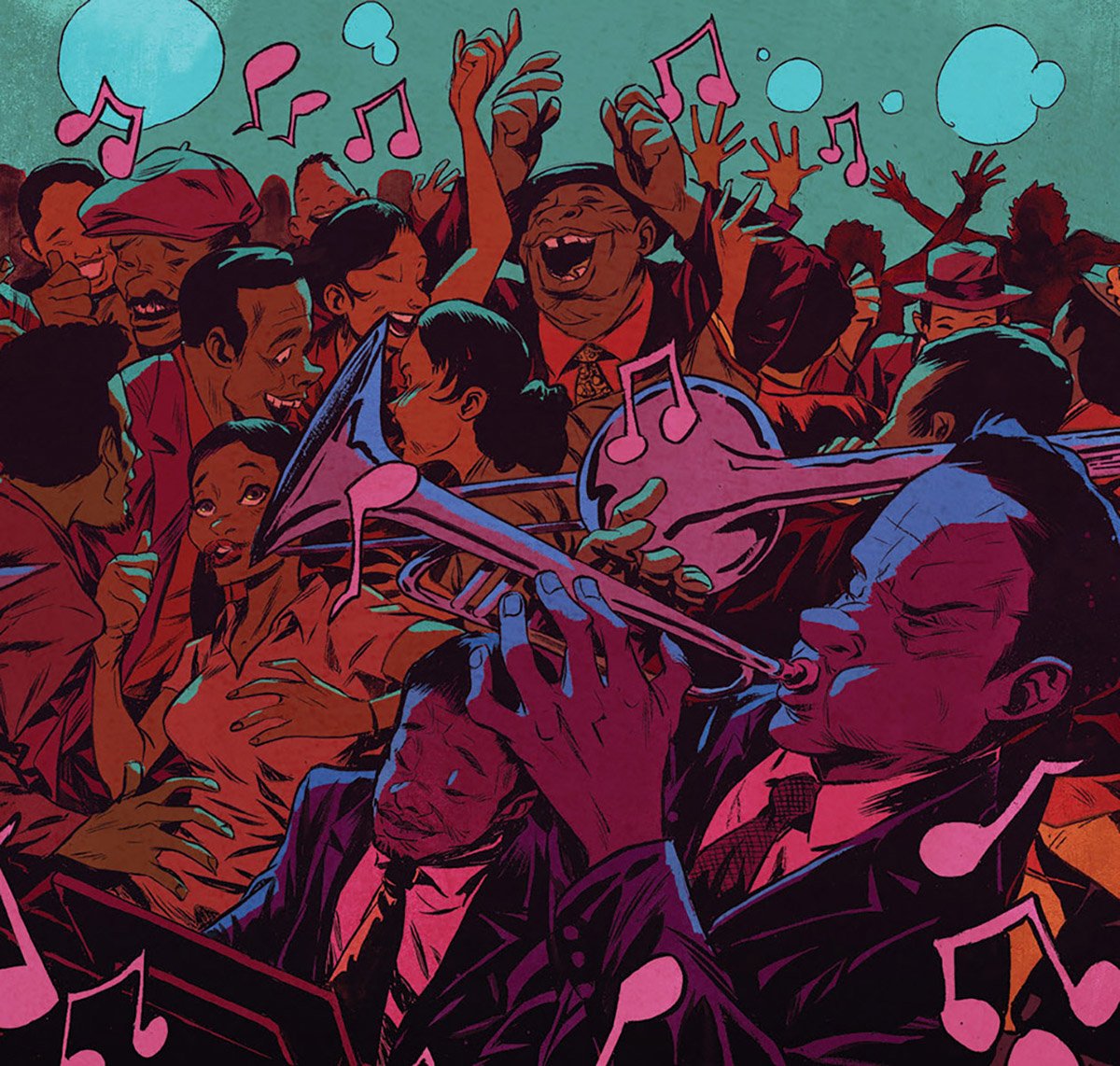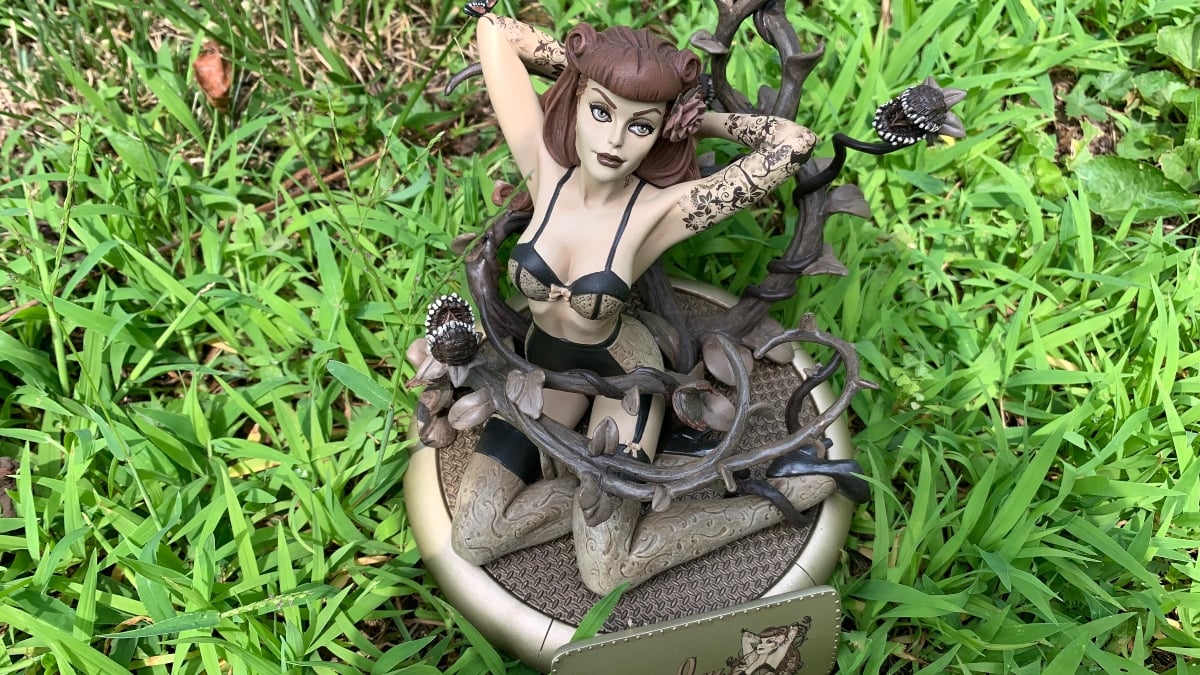Bitter Root #1
Writer: David F. Walker, Chuck Brown
Artist / Cover: Sanford Greene
Variant Cover: Mike Mignola, Denys Cowan, Brittney Williams
Release Date: November 14, 2018
Age Rating: M

When I add a title to my pull list, it’s usually because either the style of art or the strength of the storytelling really speaks to me. In some cases it’s both. Bitter Root #1 is one of those cases. Before I even opened the book, I could tell the art was my jam. Once started reading, I was hooked. The story was fresh, original, and written from a perspective I don’t see often enough. The blending of a unique mythology with historical realities really works.
Beyond that, Bitter Root offers even more value in that it drops real value beyond just the art and storytelling. Intertwined with an exciting and intriguing story are some harsh historical realities that would do for us (Americans) to remember so we all ensure they are never repeated. All of this happens in a setting that is a reminder of (or for some people an introduction to) a historically significant time period that is all too often passed over.
First let me take a second to point out that this comic drops this coming Wednesday, November 14, 2018. I cannot encourage you enough to hit up you local comic shop and make sure you add it to your pull list. At bare minimum, go to Image and grab a copy or subscribe. If you are hitting a store, grab a couple of copies because they’ve got some great variant covers.
Now, let’s talk about the several reason you need Bitter Root #1 in your life and comic collection:
The Art
I love the divergent art style. It’s not your standard super hero smooth lines and basic shades. You can see some of hint of the work he’s done for Marvel and DC in the style and yet it has a vibe to it that’s different; it stands out on its own. There is something in his use of shades and the detail of his environment that give every panel the feeling of activity. Nothing in the real world happens in a vacuum and Greene captures the feel of a humming city and a busy household in a way that you don’t just see it—you can feel it. It’s almost audible the little noises that you’d hear in Ma Etta’s Kitchen, the sounds of the street outside as Blink flips the door sign to closed. In every scene there is so much to take in and, yet, it doesn’t feel crowded, just real. Even the Jinoo feels like it could be real—the lined forehead, the bulging veins in its arm.
Some might describe the art as gritty but I’d say they were off base. It’s not gritty—it’s 1920s. It’s exactly the perfect style for the time, the place, and the story. It’s got the right feel. Greene’s art is full of life. In some scenes you can feel—really feel—the beauty of life. You can practically hear the music and laughter. In other scenes, you can’t help but be aghast at the horror, amazed at how close to the edge of death our heroes work, and feel the vicious sting of hatred.
There’s also a beautiful realism to his characters. An almost Norman Rockwell level of realism in some scenes. Berg, Blink, and Cullen, all look very similar to friends of mine. It makes it easier to invest in a tale when your heroes aren’t unrealistically similar in build, insanely muscular/tall (though Berg might be taller than I am gauging), or conventionally perfect beauties. Blink is undeniably pretty but she’s pretty in the way a real-life woman is pretty, Ma Etta is wrinkled and care-worn but not in an over-the-top manner that makes her a caricature; she simply wears the believable years of a woman who’s been raising and training generation of warriors in a world that doesn’t appreciate and is barely aware of the work they do.
Greene does an amazing job making you feel even without the words. You don’t just cognitively register whether a scene should be scary, or fun, or painful. You feel it. That is true art. Evoking the empathy and forcing you to feel is tough in a comic but Greene accomplishes this consistently. Also, he is an anime fan and that’s an automatic +10 to cool in my book.
The Story
By blending a unique mythology and lore with the realities of a historically significant time period, Walker and Brown had created something truly special. There’s a saying that, “There is nothing new under the sun.” It’s been attributed to dozens of different people so I won’t try to guess which is right. And while Walker and Brown may have drawn pieces from here and there, the story that they’ve created is as fresh and original as it gets.
On the surface it’s the tale of a family of monster hunters, in a time period where humans could be just as monstrous as the Jinoo. That alone is going to be an exciting, action-packed story if Bitter Root #1 is anything to go by. But there is so much more to this series. There are truths blended into the great story and you can already see the allegory in this tale. I think, assuming no one gets idiotically offended over the last scene in this comic (there is always one), this series might prompt some real critical thinking and maybe some good conversation about the real monsters that we see in our world today—hatred, racism, violence, xenophobia…
After you read Bitter Root #1, I really encourage you to take the time to read the back matter carefully. Walker and Brown wrote an excellent essay that gives us a peek into where the inspiration for their title and lets us know where it’s going:
“One of the greatest horrors we face is racism. It is an ignorant, vile, viscous monster that lurks in humanity’s past, present, and, sadly in our future. Bitter Root takes this monster and gives it face and a body and an uncontrollable desire to kill. But this series also gives hope in fighting this vicious monster, and that hope comes in the form of the Sangerye family. The Sangeryes are fighting a never-ending battle to combat and extinguish the monster born out of racism, intolerance, and hate. Bitter Root is filled with action, drama, laughs, and amazing artwork. But at its core, this series is a call to combat the bitter root of racism and hate.” ~ David Walker and Chuck Brown (That ain’t nothing but the Devil!)
Bitter Root #1 is an Ethno-Gothic tale that offers the reader more than just an excitingly original horror tale. For those of you thinking that Gothic is Victorian era Eurocentric, keep in mind that a part of the Goth/Gothic aesthetics borrow heavily from other cultures. The Goth culture has roots in many cultures especially African and Egyptian.
Not Your Standard White Guys
Bitter Root #1 is the tale of the Sangeryes family. This family has been hunting monsters for generations. It’s the family tradition and each generation trains the next. More than just being monster hunters, they are Black Americans dealing with all of the racial issues of America in the 1920s. They’ve suffered tragedy and loss but they’ve never shied away from their calling. That alone would make Bitter Root #1 a story worth the read but now set this tale in 1920s America, in Harlem. Now we are looking at an incredible family dealing with both supernatural monsters and the monsters of racial hatred. The battle is an uphill one and not everyone that they are protecting knows or cares. Yet, this family is all that stands between the citizens of New York City and a monster apocalypse.
Each family member has a distinct and endearing personality. I liked every one of them right off though I admit Berg and Blink are my favorites.
- Berg is a huge bald guy with the demeanor of a zen master and a vocabulary that would shame most college professors. He’s smart, has a dry sense of humor, and you can almost hear his warm laugh. He’s fast too—as in “stopping bullets with a staff” level fast.
- Cullen is dramatic. He’s clearly sensitive to the suffering of others. I don’t think he’s cut out to be a fighter but he’s no coward. I can’t wait to learn more about him because you get the sense that he’s meant for something big, but something different than what his family duty is currently.
- Blink is easily my favorite character. Smart, sassy, and feeling a bit trapped by her assigned family role. She’s a fighter, and that’s not hyperbole. She literally kicks monster butt. She’s good at it, you can see she believes it was what she’s born to do but she’s bound by her familial responsibilities and her respect for her grandma.
- Ma Etta is Blink’s grandma and the matriarch of the Sangeryes. She’s a small, 80-ish woman wearing a head wrap. While she looks like a little frail old black lady, I’m laying heavy bets that she is not as frail as she appears. She’s got a very Yoda vibe about her. She worries about Blink because she blames herself for losing her daughter, and that’s part of why she’s so strict with Blink. It’s straight up love, tough love, but real love too.
The Harlem Renaissance
One of the refreshing things about Bitter Root #1 is that it is set in Harlem and during the Harlem Renaissance, an extremely underrated historical period. In the 1920s, Harlem gave birth to a veritable cornucopia of African American creativity, both intellectual and artistic. Black writers, musicians, and artists created works that not only altered the shape of writing, art, and music in the best possible way, but also set the stage for the Civil Rights Movement by asserting their cultural identity.
The Harlem Renaissance is not just a part of Black History; this is a huge and important part of American History (if you’ve never heard of it, click the link to start learning but don’t stop there), which is all often passed over in most history classes. It marks a point in history when White America finally sat up and took notice of the intellectual contributions of Black creators.
By setting Bitter Root #1 in this time period, in this place full of rich culture and history, readers, who might never have heard of the Harlem Renaissance, are introduced to (or reminded of) a very significant time period in history. A time that gave us some of the very best of the arts, inspired great thinkers, and gave birth to black pride.
Bitter Root #1 is for Everyone Except Children
While Bitter Root #1 is an excellent comic, one I believe everyone should read (did I mention that it hits store shelves on November 14? That’s tomorrow—hint, hint). I want to caution parents that this is a horror comic. It’s intended for a mature audience. It’s also depicts violent racism and will address the human monsters as well as the supernatural. This is one of those comics that can change who you are and how you see the world. Titles like this are part of why reading comics can make you smarter. Comics need more creators with the talent, imagination, and perspective of this amazing team.









